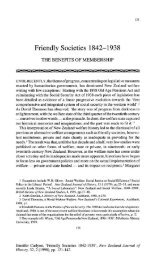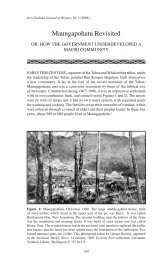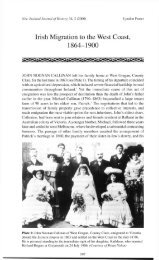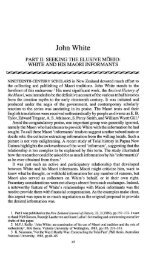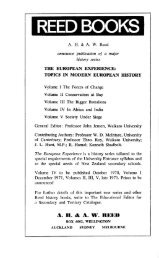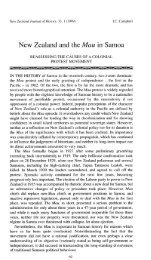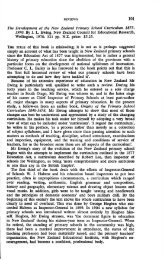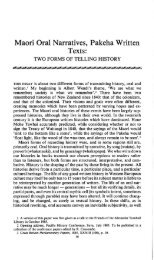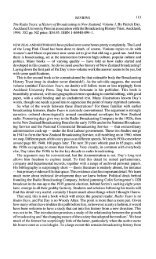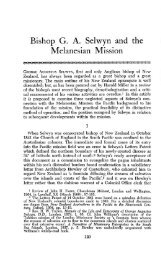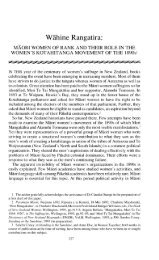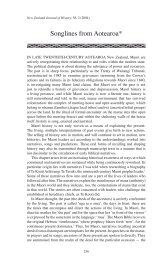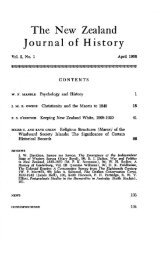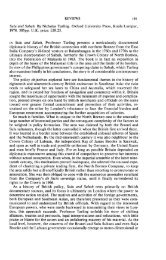'At Every Bend a Taniwha': - New Zealand Journal of History
'At Every Bend a Taniwha': - New Zealand Journal of History
'At Every Bend a Taniwha': - New Zealand Journal of History
Create successful ePaper yourself
Turn your PDF publications into a flip-book with our unique Google optimized e-Paper software.
<strong>'At</strong> <strong>Every</strong> <strong>Bend</strong> a <strong>Taniwha'</strong>:<br />
THOMAS KENDALL AND MAORI CARVING<br />
THOMAS KENDALL'S writings on Maori religious beliefs are <strong>of</strong> particular<br />
significance not merely because they are among the earliest but because<br />
he recognized that a definite relationship existed between Maori carved<br />
images and Maori cosmological thought. For the first time, his views have<br />
been taken into account in a full length study <strong>of</strong> carving: David Simmons's<br />
Whakairo. Maori Tribal Art, published in 1985. It may, therefore, be <strong>of</strong><br />
interest to publish a previously unknown letter written by Kendall on<br />
Maori religious ideas. In my own earlier analyses <strong>of</strong> Kendall's material<br />
I have deliberately made available the texts <strong>of</strong> his significant manuscripts<br />
on Maori religion and carving so that others might have access to them. 1<br />
This article is intended, initially, to serve the same purpose, but I will<br />
then go on to discuss Simmons's use <strong>of</strong> Kendall's accounts.<br />
The letter was written when Kendall was living, under considerable stress,<br />
in <strong>New</strong> South Wales. He had left <strong>New</strong> <strong>Zealand</strong> six years earlier in February<br />
1825. However, he had maintained his interest in the Maori language and<br />
had already made one attempt to have a revised edition <strong>of</strong> his 1820 A<br />
Grammar and Vocabulary <strong>of</strong> the Language <strong>of</strong> <strong>New</strong> <strong>Zealand</strong> published<br />
in Sydney. This had been blocked by the Reverend Samuel Marsden,<br />
whose continuing hostility to Kendall, dismissed from the <strong>New</strong> <strong>Zealand</strong><br />
mission in 1822, may partly explain the pseudonym under which Kendall<br />
published his last known account <strong>of</strong> Maori religious thought: SOLICITUS,<br />
or one who cares.<br />
1 The text <strong>of</strong> the main letter, dated 27 July 1824, is published as Appendix I in Judith<br />
Binney, The Legacy <strong>of</strong> Guilt. A Life <strong>of</strong> Thomas Kendall, Auckland, 1968. The drawing<br />
which accompanied it is reproduced and discussed in Judith Binney, 'The Lost Drawing<br />
<strong>of</strong> Nukutawhiti', <strong>New</strong> <strong>Zealand</strong> <strong>Journal</strong> <strong>of</strong> <strong>History</strong>, XIV, 1 (April 1980), p. 4. The three<br />
letters which listed and described the carvings are in Binney, Legacy, pp. 134-5.<br />
132
'AT EVERY BEND A TANIWHA' 133<br />
ORIGIN, LANGUAGE, AND RELIGION OF THE NEW<br />
ZEALANDERS.<br />
To the Editor <strong>of</strong> the Sydney Gazette.<br />
SIR,<br />
As there are several natives <strong>of</strong> <strong>New</strong> <strong>Zealand</strong> now resident in this Colony,<br />
and fresh visitors from thence may be seen daily walking along the streets<br />
<strong>of</strong> this metropolis, it may not perhaps be unacceptable to you (who have<br />
on all occasions manifested the warmest interest in the welfare <strong>of</strong> the<br />
heathen), and likewise to some <strong>of</strong> your readers, to be presented with a<br />
brief account <strong>of</strong> the most remarkable traditions respecting the origin,<br />
language, and religion <strong>of</strong> that noble race <strong>of</strong> human beings, concluding<br />
with some observations from Scripture prophecy respecting them, by way<br />
<strong>of</strong> encouragement to such Missionaries as labour amongst them.<br />
The <strong>New</strong> <strong>Zealand</strong>ers, as may be collected from their ancient songs and<br />
themes, came from the west. They say that the god Pan* accompanied<br />
their progenitors from the land called Shawahiki,# or the Nursing River,<br />
or Fertile Field, in search <strong>of</strong> the long-haired or life preserving garment.<br />
That the properties <strong>of</strong> this garment were most invaluable, insomuch as<br />
those who originally wore it were immortal. They also affirm, that the<br />
priests who accompanied them in the expedition pointed out one <strong>of</strong> the<br />
Magellan clouds as the garment they had lost. At the place whence they<br />
took their departure, they saw the cloud or garment on the verge <strong>of</strong> the<br />
horizon. Pan and his comrades, finding that by sailing towards it, the<br />
higher and more distant it was from him, he became so enraged at the<br />
disappointment, that he threw up his vessel at it, where it now remains<br />
in the constellation Argos. The principal tradition <strong>of</strong> the <strong>New</strong> <strong>Zealand</strong>ers,<br />
respecting their origin, and first arrival in their country, is connected with<br />
the Argonautic expedition. They tell us, moreover, that the country from<br />
whence they came abounded in flax, and sweet potatoes, or kai; both<br />
<strong>of</strong> which they brought with them. After many years' historical research,<br />
it is difficult for me to conjecture that the <strong>New</strong> <strong>Zealand</strong>ers emanated from<br />
any other part <strong>of</strong> the world except Egypt, or its borders, so many <strong>of</strong><br />
their traditions and customs leading me to form such an opinion. There<br />
is no language except the ancient Egyptian in which the word kaikai is<br />
used in denoting food; nor is there any country but Egypt where, even<br />
at present, the names <strong>of</strong> towns and cities correspond with <strong>New</strong> <strong>Zealand</strong><br />
names. In <strong>New</strong> <strong>Zealand</strong> hieroglyphics are made use <strong>of</strong> as they were formerly<br />
in Egypt. Pan was also worshipped there as the god <strong>of</strong> fertility, and he<br />
is so acknowledged at <strong>New</strong> <strong>Zealand</strong>.<br />
The language <strong>of</strong> <strong>New</strong> <strong>Zealand</strong> is founded on a system <strong>of</strong> philosophical<br />
rules; and the roots <strong>of</strong> the language are taken from certain primary principles<br />
agreeing with the sounds <strong>of</strong> the vowels a, e, i, o, and u, as they are<br />
pronounced by the natives; and also from elementary principles agreeing<br />
with the numbers from one to ten. Prefixes and affixes are made use<br />
<strong>of</strong> as in the Hebrew language, and many words are exactly the same<br />
in sound and signification. The language <strong>of</strong> the <strong>New</strong> <strong>Zealand</strong>ers, and
134 JUDITH BINNEY<br />
Polynesians, and indeed almost the whole <strong>of</strong> the islanders <strong>of</strong> the South<br />
Seas, bears the strictest affinity to the Coptic which was the ancient language<br />
in Egypt, making allowance for our want <strong>of</strong> knowledge <strong>of</strong> that language,<br />
and for the changes which have taken place through a succession <strong>of</strong> so<br />
many ages <strong>of</strong> the world which have passed away since the Coptic language<br />
was spoken in its original purity.<br />
The religion <strong>of</strong> the <strong>New</strong> <strong>Zealand</strong>ers is <strong>of</strong> ancient date, and in many<br />
respects is similar to that <strong>of</strong> the ancient nations <strong>of</strong> the west. They<br />
acknowledge the Host <strong>of</strong> heaven. They worship their dead ancestors and<br />
friends, which they believe are so many stars in the firmament. The left<br />
eye <strong>of</strong> a deceased person they imagine becomes a star.<br />
The cannibal feasts <strong>of</strong> the <strong>New</strong> <strong>Zealand</strong>ers are sacramental rites, instituted<br />
from time immemorial, and are <strong>of</strong> acknowledged importance and necessity.<br />
The prophet <strong>of</strong> the <strong>New</strong> <strong>Zealand</strong>ers is a person well skilled in the<br />
knowledge <strong>of</strong> future events. The priest <strong>of</strong> the <strong>New</strong> <strong>Zealand</strong>ers is their<br />
spiritual head, or ratherly spiritual covering. The king <strong>of</strong> the <strong>New</strong> <strong>Zealand</strong>ers<br />
signifies a person possessing sovereign power and authority.<br />
Any person may set himself up for a prophet, and he will be esteemed<br />
as such, provided he prophesies the truth. The order <strong>of</strong> priesthood is regular<br />
and hereditary. <strong>Every</strong> father <strong>of</strong> a family is the priest, or spiritual covering<br />
<strong>of</strong> that family. When the father is dead, the priesthood is invested in<br />
his eldest son. Sometimes aged women act as priestesses. All free persons,<br />
or heads <strong>of</strong> families, are called kings. The word for king seems to be<br />
taken from a commander giving orders with a loud voice, and the<br />
surrounding subjects hearing and obeying his call. A man may be a prophet,<br />
priest, and king, in his own person.<br />
The <strong>New</strong> <strong>Zealand</strong>ers keep the hair <strong>of</strong> their heads, and their backs, between<br />
the shoulders, sacred. They believe that the progress <strong>of</strong> the soul during<br />
its present state <strong>of</strong> existence is connected with the hair <strong>of</strong> their head:<br />
they also suppose the back to be the seat <strong>of</strong> the deity, who, while he<br />
whispers knowledge into their ears, he also by the exercise <strong>of</strong> his power<br />
on their backs enables them to perform, with due effect, their respective<br />
duties.<br />
It has frequently occurred to my mind in consideration <strong>of</strong> the Israelites<br />
having <strong>of</strong>ten been connected with the Egyptians, and many <strong>of</strong> them having<br />
from time to time been carried away with their idols worshipping the<br />
host <strong>of</strong> heaven; it is on that account very probable that many <strong>of</strong> the<br />
South Sea Islanders may be descendants <strong>of</strong> the children <strong>of</strong> Israel. The<br />
natives <strong>of</strong> <strong>New</strong> <strong>Zealand</strong> in particular, according to their mode <strong>of</strong><br />
interpretation, are well acquainted with, and personally interested in the<br />
Blessing <strong>of</strong> Moses, in the tribe <strong>of</strong> Benjamin. 'The beloved <strong>of</strong> the Lord<br />
shall dwell in safety by him, and the Lord shall cover him all the day<br />
long, and he shall dwell between his shoulders. The deity is a spiritual<br />
covering, as well as a spiritual supporter and protection: He dwells between<br />
the shoulders.' It may be noticed that many <strong>of</strong> the rites and ceremonies<br />
<strong>of</strong> the <strong>New</strong> <strong>Zealand</strong>ers are apparently <strong>of</strong> Jewish origin.
'AT EVERY BEND A TANIWHA' 135<br />
It has been justly observed,? 'that the position which this Colony occupies<br />
in the southern hemisphere gives it a peculiar interest to the friends <strong>of</strong><br />
Missions, as it possesses peculiar facilities for the dissemination <strong>of</strong> Gospel<br />
light amongst the numerous islands situated at no great distance from<br />
it, whose inhabitants are covered with the thickest darkness <strong>of</strong> pagan<br />
superstition;' and it is presumed they may derive encouragement to go<br />
on in their benevolent work, when they compare the miserable and<br />
deplorable state <strong>of</strong> the South Sea Islanders at the time they were first<br />
visited by Europeans, with the rapid advances which many <strong>of</strong> them have<br />
already made in the scale <strong>of</strong> civilization, notwithstanding the many obstacles<br />
with which the servants <strong>of</strong> Christ have had to contend, who live amongst<br />
them.<br />
With respect to the islands <strong>of</strong> <strong>New</strong> <strong>Zealand</strong> in particular, when the<br />
celebrated navigators, Cook and Marion, visited them, and the former<br />
took possession <strong>of</strong> them in the name <strong>of</strong> the King <strong>of</strong> Great Britain, the<br />
natives were then so wild and barbarous it was impossible for civilized<br />
Europeans to trust themselves among them without terror; indeed, the<br />
general manner <strong>of</strong> the natives in their first approach to strangers, must<br />
have been very terrific to the minds <strong>of</strong> men unaccustomed to their<br />
unmeaning clamour. They were not only hasty in the manifestation <strong>of</strong><br />
their cruel disposition towards strangers, but were barbarous in the extreme<br />
among themselves, continually seeking opportunities to gratify their savage<br />
dispositions, the weaker party always becoming a prey to the more powerful;<br />
furious in war, and having no other principle to restrain their fury, but<br />
the power <strong>of</strong> their adversary's arms.<br />
The <strong>New</strong> <strong>Zealand</strong>ers were indeed a terrible people, and they continued<br />
in this woeful state until the arrival <strong>of</strong> the Missionaries, in the year 1814,<br />
when many <strong>of</strong> them, especially the young people and children who were<br />
situated near the Missionaries, and were as opportunity <strong>of</strong>fered instructed<br />
by them, soon began to show evident signs <strong>of</strong> a docile and improving<br />
genius; the progress they made was notwithstanding very slow, and the<br />
Missionaries, as might be expected, had many obstacles and hardships<br />
to encounter. When the first schoolhouse was erected, and the school<br />
was opened, parents, children, and slaves rushed in, and not only filled<br />
the inside, but almost literally covered the ro<strong>of</strong>. They were so extravagant<br />
in their deportment that nothing was to be heard but shouting, singing,<br />
and dancing. After this, many tedious years elapsed before the Missionaries<br />
could bring their pupils to any kind <strong>of</strong> order, but at length they have<br />
prevailed, and by the Divine blessing, they have become eminently useful<br />
in correcting their wild habits, training them up to habits <strong>of</strong> industry,<br />
and in giving them a Christian education.<br />
The fundamental truths <strong>of</strong> the Christian religion having been presented<br />
to the natives <strong>of</strong> <strong>New</strong> <strong>Zealand</strong>, the Society Islands, Owhyhee, and the<br />
Tonga islands in their own tongue, in books printed for that purpose;<br />
they have now every fair opportunity <strong>of</strong> becoming acquainted with the<br />
way <strong>of</strong> salvation, and <strong>of</strong> teaching others <strong>of</strong> their own nation what they
136 JUDITH BINNEY<br />
have been taught themselves. Some <strong>of</strong> them have happily experienced<br />
the benign influence <strong>of</strong> Christianity; they can read and pray, and sing<br />
the Redeemer's praise; and we may reasonably indulge the hope, that<br />
every succeeding year will bring fresh laurels to the cause <strong>of</strong> Christ among<br />
them.<br />
There is now, and always has been, one very material obstacle to the<br />
introduction <strong>of</strong> Missionaries, and the consequent dissemination <strong>of</strong> religious<br />
knowledge amongst the natives <strong>of</strong> the South Seas, namely, the difficulty<br />
<strong>of</strong> obtaining a means <strong>of</strong> conveyance, owing chiefly to the particular situation<br />
<strong>of</strong> the islands, separated from each other by the sea, and at so great a<br />
distance from those parts <strong>of</strong> the world which are frequented by ships<br />
and trading vessels; and this circumstance reminds me <strong>of</strong> an ancient<br />
prophecy, recorded in the 18th chapter <strong>of</strong> Isaiah, in which the Prophet<br />
speaks <strong>of</strong> a 'land that sendeth ambassadors by sea in vessels <strong>of</strong> bulrushes,<br />
to a nation scattered and peeled; to a people terrible from their beginning<br />
hitherto; a nation rooted out and trodden down, whose land the rivers<br />
have spoiled.'' to a people who have long been cut <strong>of</strong>f from all intercourse<br />
with the civilized world. There is also another prophecy recorded in the<br />
16th chapter <strong>of</strong> the Book <strong>of</strong> Revelations, which bears an evident relation<br />
to this subject. St. John says, 'the sixth angel poured out his vial upon<br />
the great river Euphrates, and the waters there<strong>of</strong> was dried up, so that<br />
the way <strong>of</strong> the kings <strong>of</strong> the East might be prepared.' Hence it appears,<br />
that the kings <strong>of</strong> the East have been long kept in their sad captivity by<br />
the waters <strong>of</strong> this great river which surrounds them. That the waters <strong>of</strong><br />
this river will be dried up, or in other words, 'that the messengers <strong>of</strong><br />
Christ will have an opportunity <strong>of</strong> being conducted dryshod over it, and<br />
thus the way <strong>of</strong> the kings <strong>of</strong> the East be prepared,' I can entertain no<br />
doubt, because the scripture assures me that this glorious event shall in<br />
due time be accomplished. But what these vessels <strong>of</strong> bulrushes are, or<br />
how these vessels <strong>of</strong> a particular construction will be obtained and employed<br />
in the above service, only time can determine. I would just remark, that<br />
that part <strong>of</strong> the Pacific Ocean in which the most numerous islands are<br />
situated, is only like a lake; many <strong>of</strong> them can be seen with the naked<br />
eye at a short distance from each other. But in order to establish a regular<br />
and speedy communication, vessels ought to be so constructed as to proceed<br />
from west to east with the same facility as they move from east to west,<br />
on account <strong>of</strong> the trade winds. I should associate with the idea <strong>of</strong> the<br />
vessel <strong>of</strong> bulrushes the steam vessel, but I shudder at the thought <strong>of</strong> the<br />
expense, except mercantile gentlemen <strong>of</strong> this colony could find out a<br />
sufficient object for the employment <strong>of</strong> their capital, by such an expeditious<br />
mode <strong>of</strong> trade amongst the islands, and thereby afford Missionaries the<br />
more frequent opportunities <strong>of</strong> obtaining a means <strong>of</strong> conveyance; the<br />
spiritual interests <strong>of</strong> the islanders under such circumstances, going hand<br />
in hand with the temporal.<br />
It ought not to be forgotten, that by the liberality <strong>of</strong> the Church<br />
Missionary Society, the Islands <strong>of</strong> <strong>New</strong> <strong>Zealand</strong> are provided with a vessel.
'AT EVERY BEND A TANIWHA' 137<br />
But what are these Islands when compared with the almost countless islands<br />
<strong>of</strong> the South Seas which are still without a vessel?<br />
From the preceding remarks, and from the continuation <strong>of</strong> St. John's<br />
description <strong>of</strong> the pouring out <strong>of</strong> the sixth vial, the sentiments corresponding<br />
with the ideas <strong>of</strong> the <strong>New</strong> <strong>Zealand</strong>ers, &c. it will not be difficult to form<br />
a correct idea who the kings <strong>of</strong> the East are, the spiritual powers <strong>of</strong> the<br />
most noxious reptiles, even frogs being included in their religious system.<br />
Wretched as the islanders are, they call themselves kings, and as it was<br />
one great object <strong>of</strong> our gracious Redeemer when on earth, to fulfil scripture<br />
prophecy, it must be a work undoubtedly acceptable to Him, to imitate<br />
his example, remembering, that He will finally confess those before his<br />
father, and before the Holy Angels, who confess Him before the world.<br />
1 remain.<br />
Sir,<br />
your very obedient servant,<br />
SOLICITUS: 2<br />
* Pronounced Panee.<br />
#From E. hawha hiki.<br />
tResolution <strong>of</strong> the Wesleyan Auxiliary Missionary Society.<br />
The internal evidence leaves one with no doubt that this letter was<br />
composed by Kendall. It contains references to ideas which he had dwelt<br />
on obsessively from at least 1820. In particular, he mentions the supposed<br />
'Argonautic' traditions associated with the Greek god Pan, and the notion<br />
that each <strong>of</strong> the five Maori vowels possessed a particular symbolic meaning<br />
relating to the cosmology. He also recalls here the excitement at the opening<br />
<strong>of</strong> the first school, at Rangihoua in August 1816, where he had taught.<br />
In addition he quotes from a resolution he had seconded at the Sydney<br />
meeting <strong>of</strong> the Wesleyan Auxiliary Missionary Society on 4 October 1830.'<br />
The letter also reveals the essential problems with Kendall's material:<br />
he was obsessed with the conviction that the Maori were descendants<br />
<strong>of</strong> Egyptians, who had at some time come into contact with the lost tribes<br />
<strong>of</strong> Israel and their language, Hebrew. Therefore he argued that the Maori,<br />
who were Eastern Polynesian in their origins, came from the west. He<br />
imposed a hermeneutic system <strong>of</strong> explanation, based on the Scriptures,<br />
upon all events. He, like many others to follow him, applied amateurish<br />
deductions to word origins and the seeming similarities between proper<br />
names. He believed Pan to be an Egyptian deity and built theories around<br />
that confusion. In a letter he had written in 1821 he argued that Pan<br />
was 'universally acknowledged'. This God was, he asserted, specifically<br />
associated with the regular overflowing <strong>of</strong> the Nile, and the consequent<br />
fertility <strong>of</strong> Egypt. This confusion <strong>of</strong> Osiris and Pan was common in late<br />
eighteenth century European thought. Pan, his crook, and his pipes, and<br />
2 Sydney Gazette, 8 January 1831, p. 3.<br />
3 Sydney Gazette, 7 October 1830, p. 2.
138 JUDITH BINNEY<br />
'his <strong>of</strong>fice in making the earth fertile' were, Kendall said, all alluded to<br />
in Maori tradition. 4 The 'Nursing River', introduced in the letter quoted,<br />
was a false association derived from Kendall's equation <strong>of</strong> the words 'awa<br />
hiki' with Hawaiki, the ancestral homeland.<br />
A similar, somewhat confused derivation seems to lie behind his statement<br />
about the origin <strong>of</strong> the word for 'king'. He is, presumably, commenting<br />
upon the term 'rangatira'. He interpreted it as being a composite <strong>of</strong> 'rangi',<br />
a term used for chief (particularly as a form <strong>of</strong> address) and which also<br />
means to sing, and is the thrust or tenor <strong>of</strong> a speech, and 'tira', a company<br />
or party <strong>of</strong> men. Kendall observed, without understanding the reason,<br />
that Maori men <strong>of</strong> rank considered their hair to be tapu. Maori men<br />
wore their hair long, and hair was tapu because it conveyed the lines<br />
<strong>of</strong> descent from the ancestors and the gods. The word 'iho' means both<br />
the hair and the umbilical cord which attaches the child to its mother.<br />
Men's backs, between their shoulder blades, were also particularly tapu,<br />
possibly because the bones <strong>of</strong> the exhumed dead would be carried there.<br />
Kits <strong>of</strong> food placed on their backs would violate their personal tapu. To<br />
be tapu — and all human beings intrinsically possessed a quality <strong>of</strong> tapu<br />
— was being under the influence <strong>of</strong> the gods; and certain parts <strong>of</strong> the<br />
body, by extension, particularly with men, were intensely tapu. But Kendall<br />
immediately leapt to the conclusion that these beliefs were derived from<br />
Israelite practices. Under the laws <strong>of</strong> Moses the Israelites kept their hair<br />
long as a sign <strong>of</strong> their dedication to God (Numbers 6: 5). Kendall cited<br />
Deuteronomy 33: 12 as evidence as to the origin <strong>of</strong> the Maori belief in<br />
the sacredness <strong>of</strong> the shoulders. It was in such ways that he found<br />
explanations for Maori beliefs which would fit into his Scripturally-shaped<br />
preconceptions as to the origins <strong>of</strong> all mankind. Not all his observations<br />
are so distorted. He noticed, for example, that 'aged women' (or women<br />
past the age <strong>of</strong> child-bearing) could be priestesses. Women were also<br />
prophets, which role he correctly distinguished. The early nineteenth century<br />
visionary Papahurihia, who lived at Waima in the Hokianga, derived some<br />
<strong>of</strong> his powers from his mother, Taimania, who herself claimed to be an<br />
oracle.<br />
Kendall was particularly intrigued by the god Pan ('Panee'), who was<br />
probably the female deity Pani-Tinaku, the mother <strong>of</strong> kumara. She was<br />
the wife <strong>of</strong> the important male god <strong>of</strong> fertility and planting, Rongo or<br />
Rongo-ma-Tane. She was impregnated by her husband, who in this<br />
particular narrative sequence was called Rongo-Maui, and she brought<br />
forth the kumara. Pani was also the adoptive mother <strong>of</strong> the trickster Maui,<br />
who witnessed, hidden in her girdle, the birth <strong>of</strong> her children. The Pani<br />
myth is one <strong>of</strong> the central cosmological narratives, concerned as it is with<br />
the origin <strong>of</strong> the kumara, intrinsically tapu, but which, as cooked food,<br />
4 To Rev. A. Waugh, 25 November 1821, The Evangelical Magazine, and Missionary<br />
Chronicle, XXX (1822), p. 330.
'AT EVERY BEND A TANIWHA' 139<br />
can destroy tapu and so bring death. 5 Kendall was not alone in his<br />
fascination with these concepts. Elsdon Best, equally influenced by the<br />
European mythologies and as intrigued by the apparent parallels, described<br />
Pani in not dissimilar terms to Kendall: 'Pani takes the place <strong>of</strong> Ceres<br />
<strong>of</strong> corn producing lands'. 6 Best also became confused about Rongo, god<br />
<strong>of</strong> agriculture, and 'Rongo-ma-Tane', whom he saw as the two gods Rongo<br />
and Tane, gods <strong>of</strong> agriculture and mankind. He called them the 'twins<br />
<strong>of</strong> Maori myth'. They were, he said, the essential deities, 'Isis and Osiris<br />
. . . gods <strong>of</strong> Accadia and <strong>of</strong> Egypt [who had] survived in the far-flung<br />
isles <strong>of</strong> Polynesia to our own time'. 7 Rongo he equated with the female<br />
deity Isis, and Tane he equated with Osiris. Kendall had identified Pan<br />
with Osiris because the very limited sources available to him had already<br />
done so. 8<br />
It was these kinds <strong>of</strong> confusions which led me in The Legacy <strong>of</strong> Guilt<br />
to treat Kendall's material with great caution. Nevertheless, the discovery<br />
<strong>of</strong> the drawing he had made in 1824 <strong>of</strong> Nukutawhiti, the canoe ancestor<br />
<strong>of</strong> Ngapuhi, carved on the entrance-way, or kuwaha, <strong>of</strong> a pataka revealed<br />
that he had some grasp <strong>of</strong> the mythological elements portrayed. Nukutawhiti<br />
was a carving <strong>of</strong> the ancestor in the 'first state <strong>of</strong> existence', or existence<br />
before life in this world. The entrance into the tapu storehouse was described<br />
as the entrance-way into the second state <strong>of</strong> existence, this world. To enter<br />
the pataka without lifting the tapu correctly was to undergo a change<br />
<strong>of</strong> state, that is, death. The door stood as the passage to or from this<br />
world. The drawing illuminated some <strong>of</strong> the ideas which Kendall had<br />
tried to convey in his letters.<br />
In Whakairo Simmons has drawn extensively on Kendall for the<br />
mythological 'level <strong>of</strong> meaning' <strong>of</strong> some carvings. He states that the<br />
'connection between the symbolism and carving is given by Kendall'. His<br />
other, confirmatory, source is said to be the oral information from Te<br />
Riria, who was taught, he claims, at the whare wananga Te Arikimohowhakaitiiti<br />
at Wairoa in Hawke's Bay. The Ahupiri Council <strong>of</strong> elders<br />
is also stated as having given its approval to the final text. 9 Te Riria<br />
is not, however, identified. He is James Ngatoa <strong>of</strong> Ngati Kahungunu and<br />
Ngati Ngaherehere, who lives in Auckland and who claims the ariki title<br />
Te Riria V <strong>of</strong> the United Tribes. Even more curiously, the Ahupiri Council<br />
is not identified, although it claims to represent all the tribes, and to be<br />
associated with the Huiarau Parliament, or Runanga, which is said to<br />
have last met in September 1947. The permanent head <strong>of</strong> the 'house' <strong>of</strong><br />
the Runanga was the chiefly holder <strong>of</strong> the toki poutangata, the sacred<br />
5 Jean Smith, Tapu Removal in Maori Religion, Wellington, 1974, pp. 53-58; Michael<br />
P. Shirres O.P., 'Tapu', The <strong>Journal</strong> <strong>of</strong> the Polynesian Society, XCI, 1 (March 1982), pp.<br />
38-40.<br />
6 Elsdon Best, Maori Religion and Mythology, Wellington, 1982, II, p. 237.<br />
7 Elsdon Best, Maori Religion and Mythology, Wellington, 1976,1, p. 179.<br />
8 Binney, Legacy, pp. 138-9.<br />
9 David Simmons, Whakairo. Maori Tribal Art, Auckland, 1985, p. 19.
140 JUDITH BINNEY<br />
adze called Iriperi Ko Tama, which was entrusted by Te Riria to the<br />
Auckland Museum in 1980. 10 It is not my intention to discuss at any<br />
length the reliability or otherwise <strong>of</strong> the oral material. I leave that to<br />
others better equipped. It is however necessary to recognize that Simmons<br />
has distorted Kendall's statements.<br />
The fundamental confusion is Simmons's claim that the 'three states<br />
<strong>of</strong> existence', as Kendall described the Maori cosmology, were Te Kore,<br />
Te Po, and Te Ao Marama. 11 Te Ao Marama, this world, is stated to<br />
be the third realm <strong>of</strong> existence. 12 Kendall gave no Maori name to any<br />
<strong>of</strong> these 'States or Modes <strong>of</strong> Existence', 13 but he was quite explicit in<br />
his sequence. The first state <strong>of</strong> existence was timeless. It was a formless<br />
mass <strong>of</strong> pure food and pure seed and it was 'tapu', that is, it possessed<br />
the potentiality <strong>of</strong> life. It was the union <strong>of</strong> all matter — 'creation in pure<br />
Embryo'. 14 He described this state as a 'State <strong>of</strong> Union'. It was his attempt<br />
to render Te Kore and Te Po <strong>of</strong> the cosmological chants. The second<br />
state he described as life in this world. Two pieces <strong>of</strong> carving he sent<br />
to England in 1823 were said specifically to represent 'man in his second<br />
state or this world.' 15 He described this state as 'Dual'. The third state<br />
<strong>of</strong> existence was life after this world. It was Te Po, where the spirits <strong>of</strong><br />
the newly dead were received by Hine Nui Te Po and reunited with the<br />
ancestors. Kendall described it as a state <strong>of</strong> 'rest', 'Station', and reunion.<br />
He called it 'Triune', which conveyed (to him) the notion <strong>of</strong> completion.<br />
10 The stone adze was entrusted by its holder Te Riria V, 'Te Ariki Taiparu', <strong>of</strong> Mt<br />
Wellington, Auckland, and by its keeper, Nga Hau e Wha (The Four Winds), who is Jim<br />
Thompson <strong>of</strong> Otahuhu, Auckland. Its presentation was recorded in the Auckland Museum<br />
<strong>New</strong>s, 3 (August 1980), p. [3], where Te Riria and Nga Hau e Wha are photographed,<br />
together with the chief Te Hapuku. The Ahupiri Council states that the Huiarau Runanga<br />
closed on the death <strong>of</strong> Te Rauna Te Whero (grandfather <strong>of</strong> Te Riria) on 13 September<br />
1947. Te Rauna had been the head <strong>of</strong> the 'house' <strong>of</strong> the Runanga and holder <strong>of</strong> the adze.<br />
Correspondence for the Council is addressed to Nga Hau e Wha at Otahuhu (undated<br />
document signed and circulated by Simmons). In a subsequent book, published after this<br />
article was written, Ta Moko: The Art <strong>of</strong> Maori Tattoo, Auckland, 1986, Simmons claims<br />
that the 'Kohuiarau' or 'Kohuiaroa' [sic] is the United Tribes, created in 1834 with the selection<br />
<strong>of</strong> a national flag for shipping purposes and more potently, in 1835, with the Declaration<br />
<strong>of</strong> Independence ('He wakaputanga o te Rangatiratanga o Nu Tireni'), which was signed<br />
by 52 chiefs. One <strong>of</strong> the last signatories, in 1839, was the great chief Te Hapuku <strong>of</strong> Hawke's<br />
Bay. The Huiarau Parliament, presumably, traces its antecedents from this document. Te<br />
Riria is also a major informant for Simmons's later book, where his title is now given<br />
as 'Te Arikinui Taiopuru'. Here Te Riria, with Simmons, puts forward the notion <strong>of</strong> eight<br />
tiered ranks <strong>of</strong> chieftainship associated with the Huiarau but also claimed to be older. The<br />
title taiopuru is explained as being the supreme chief, in whose lineage all lines <strong>of</strong> descent<br />
are joined, and ahupiri as being the second rank, or the paramount chiefs in a region,<br />
and comprising <strong>of</strong> more than one canoe. The Ahupiri Council, then, claims to be the council<br />
<strong>of</strong> the elders, or a confederation <strong>of</strong> tribes. Ta Moko, pp. 9, 129-30.<br />
11 Simmons, Whakairo, p. 35.<br />
12 ibid., p. 46.<br />
13 Kendall to Church Missionary Society (CMS), 11 April 1823, Kendall Letters, MS<br />
71/51, Hocken Library, University <strong>of</strong> Otago.<br />
14 Kendall to CMS, 27 July 1824, MS 71/66.<br />
15 Kendall to CMS, 3 June 1823, MS 71/54.
'AT EVERY BEND A TANIWHA' 141<br />
Simmons adds to the confusion when he writes that 'Te Po encloses<br />
the third realm Te Ao Marama.' 16 He also says that Kendall was wrong,<br />
because he had Biblical parallels in mind, when he saw the third state<br />
<strong>of</strong> existence as the underworld, or Te Rarohenga, following death. Kendall<br />
did not state that the third state was the underworld; but he did know,<br />
correctly, that the Maori conceived <strong>of</strong> life after this world. To enter to<br />
Te Po, the realm <strong>of</strong> the after-life, was a change <strong>of</strong> state, just as to violate<br />
the tapu <strong>of</strong> a war canoe by entering it incorrectly by the bow or stern<br />
would bring about, as Kendall said, 'a change <strong>of</strong> state or death'. 17<br />
A number <strong>of</strong> other errors is purveyed. Simmons asserts that 'Kendall's<br />
informants were certainly two chiefs' from the southern part <strong>of</strong> the Bay<br />
<strong>of</strong> Islands, 'Kiwikiwi and his half-brother, Whareumu <strong>of</strong> Ngati Manu',<br />
who he also says are 'known to have been trained in the Ariki whare<br />
wananga'. 18 We are told neither the school nor the source <strong>of</strong> this knowledge.<br />
It is impossible to have any certainty about Kendall's informants, but<br />
it is most likely they were Rakau, the old tohunga <strong>of</strong> Rangihoua, and<br />
Hongi Hika, chief <strong>of</strong> Kerikeri, with whom Kendall travelled to England<br />
in 1820-1 and who remained closely associated with him. It was Rakau's<br />
daughter, Tungaroa, with whom Kendall had an affair in 1821-2. Kendall<br />
acknowledged his relationship with her, and justified it by saying 'he was<br />
induced' to live with her, 'in order to obtain accurate information as to<br />
their religious opinions and tenets, which he would in no other way have<br />
obtained'. 19 Rakau, in his turn, expressed his strong feelings that Kendall<br />
should not be removed from <strong>New</strong> <strong>Zealand</strong> after this affair, 'because he<br />
had been the chief Support <strong>of</strong> the whole <strong>of</strong> them'. 20 Hongi, also involved<br />
in the defence <strong>of</strong> Kendall in 1823, argued that he could readily live with<br />
him at Kerikeri rather than leave the country. Hongi, an ariki, was known<br />
to be a priest and a prophet in the 1820s. 21<br />
The traditions upon which Kendall was drawing were, in fact, most<br />
likely to be those <strong>of</strong> the people <strong>of</strong> the north and central Bay <strong>of</strong> Islands:<br />
Te Hikutu <strong>of</strong> Rangihoua and Ngaitawake <strong>of</strong> Waimate and Kerikeri. They<br />
were closely related in descent, unlike the tribes <strong>of</strong> the southern Bay <strong>of</strong><br />
Islands in the early 1820s. The carvings themselves would probably have<br />
been made by Bay <strong>of</strong> Plenty or East Coast carvers, commissioned by<br />
the northern chiefs, a practice common at this time as missionary journals<br />
reveal. Neither Kiwikiwi nor Whareumu played any significant part in<br />
Kendall's correspondence. When he shifted to Matauwhi, on the southern<br />
16 Simmons, Whakairo, p. 45.<br />
17 Kendall to CMS, 3 June 1823, MS 71/54.<br />
18 Simmons, Whakairo, pp. 21-22.<br />
19 Sir Thomas Brisbane, reporting the account <strong>of</strong> a ship's captain <strong>of</strong> his conversation<br />
with Kendall, to the CMS, 29 April 1823, Church Mission Book II (CN/M2), p. 397, CMS<br />
micr<strong>of</strong>ilm, University <strong>of</strong> Auckland Library.<br />
20 Rev. Samuel Marsden, <strong>Journal</strong> <strong>of</strong> his fourth voyage to <strong>New</strong> <strong>Zealand</strong>, 27 August 1823,<br />
MS 177D, Hocken Library.<br />
21 J.S.C. Dumont d'Urville, Voyage de la corvette L'Astrolabe, Paris, 1831, III, p. 676.
142 JUDITH BINNEY<br />
shores <strong>of</strong> the Bay, in February 1823, he had already acquired the information<br />
he then began to write down. He had wrestled with the text <strong>of</strong> the critical<br />
letter <strong>of</strong> July 1824 (MS 71/66), for over a year, as the letters written<br />
in April 1823 specifically indicate.<br />
Simmons connects Kendall's statement, that there were 'seven first<br />
principles constituting man in his second state\ with a pattern <strong>of</strong> seven<br />
human figures, flanked by manaia, which is sometimes found on the paepae,<br />
the threshold beam <strong>of</strong> storehouses. The pattern is also carved on a sideboard<br />
<strong>of</strong> one early Ngatipikiao storehouse, Te Oha, which was built between<br />
about 1820 and 1825. Certainly Kendall, in 1823, sent away one piece<br />
<strong>of</strong> carving which seems to have been such a paepae. He described 'man'<br />
being dragged, and pushed, by a beast on either side. The 'Beast', he<br />
said, represented the sun and the moon. The sun enlightened, while the<br />
moon was 'man's time keeper'. The 'human being in the centre' had a<br />
lame leg representing the past. The sound leg was present time: man,<br />
he commented, 'is dead as to time past, and only lives in present time'. 22<br />
Simmons <strong>of</strong>fers the view that the description was <strong>of</strong> a paepae, but he<br />
then misquotes Kendall. Each <strong>of</strong> the seven principles, he says, is flanked<br />
by 'manaia with one leg up and one leg back; this represents time future,<br />
time past — man lives in the present'. 23 The passage <strong>of</strong> time in this world<br />
is said in this version to be represented by the manaia's legs, which is<br />
illogical and inaccurate. Simmons subsequently includes in the book an<br />
example <strong>of</strong> a paepae with only five human figures. Now he changes<br />
interpretation to argue that, although the carving is 'mythological' in form,<br />
the five simply represent the five paramount (but unnamed!) hapu <strong>of</strong> Ngati<br />
Porou <strong>of</strong> the East Coast. 24<br />
For the seven-figured paepae, Te Riria <strong>of</strong>fers a translation for each<br />
<strong>of</strong> the seven named principles. Thus, wisdom, 'being, or presence', power,<br />
'Rule, or Sovereignty', greatness, equity, and the seventh principle in which<br />
the first six are united, 'Perfection, Rest' become respectively, te wananga,<br />
te oranga, te ihi, te mana, te wehi, te ihowai, and te makurangi. Te Riria<br />
then rearranges the principles and attaches them in a different order to<br />
each one <strong>of</strong> the seven human figures on the sideboard <strong>of</strong> Te Oha. Te<br />
Makurangi, 'Perfection, Rest' is the central figure. It is also stated to be<br />
the spiritual canoe which journeys to the heavens. Te Ihowai is here given<br />
as the principle <strong>of</strong> 'rest', casually interchanged for 'equity'. It would appear<br />
from the evidence that Simmons has fed Te Riria the already unreliable<br />
statements <strong>of</strong> Kendall, and they are, in turn, being handed back to us<br />
as tradition. Considering that Simmons has done so much valuable work<br />
in uncovering the interferences <strong>of</strong> S. Percy Smith in the oral traditions,<br />
this would seem to be an extraordinary procedure to have adopted. Despite<br />
Simmons's knowledge <strong>of</strong> the way in which both Percy Smith and Elsdon<br />
22 Kendall to CMS, 3 June 1823, MS 71/54.<br />
23 Simmons, Whakairo, p. 30.<br />
24 ibid., p. 57.
'AT EVERY BEND A TANIWHA' 143<br />
Best were beguiled by Whatahoro Jury and the embellishments which<br />
he added to the teachings <strong>of</strong> the whare wananga <strong>of</strong> Te Matorohanga,<br />
it would seem that Simmons has not scrutinized the information which<br />
Te Riria has presented to him.<br />
In Kendall's drawing <strong>of</strong> Nukutawhiti, the deified ancestor <strong>of</strong> the iwi<br />
<strong>of</strong> Ngapuhi <strong>of</strong> the central and northern Bay <strong>of</strong> Islands and Hokianga,<br />
there is a small figure sketched below the loins <strong>of</strong> the founder. Kendall<br />
said simply, and correctly, he was 'Nuku's Son'. 25 In some whakapapa,<br />
Ngarunui is given as the son <strong>of</strong> Nukutawhiti, in others Ranginui, the<br />
Sky Father. 26 Small figures are found in many kuwaha in this position:<br />
they represent the descent line <strong>of</strong> the iwi, which may have mythological<br />
origins. Simmons claims the small figure represents 'man as yet unborn',<br />
which seems an unnecessary obfuscation.<br />
Simmons also states that above the small figure was 'the penis, or the<br />
spiritual waters'. 27 The Spiritual Waters', as Kendall called them in this<br />
drawing, were the carved convolutes between the legs <strong>of</strong> Nukutawhiti,<br />
below the penis, which is apparently being held in the right hand <strong>of</strong> the<br />
carved main figure. In the letter <strong>of</strong> July 1824 which accompanied the<br />
drawing, Kendall talked about the united waters before creation, which<br />
he called the Wai u, the united waters, or waters <strong>of</strong> the breast — that<br />
is, milk, waiu. They were 'united' because he believed that the vowel u<br />
'covered' or united the sounds <strong>of</strong> the four other vowels. U means to keep<br />
together, or to come to a purpose; it also means the breast. If Kendall<br />
was struggling with different layers <strong>of</strong> meaning, which may be conceptually<br />
related, it does not help that Simmons has added to the confusion. Simmons<br />
states that the penis, the spiritual waters, represented 'Te Waiora [a] Tane,<br />
the living waters from Te Kore, the wairua, which in this world are<br />
Waimangu, the dark waters <strong>of</strong> the heavens (rain clouds) and the Waima<br />
or white waters <strong>of</strong> the great deep. The wairua <strong>of</strong> Te Kore are the source<br />
<strong>of</strong> all life.' 28 This passage is a muddled derivation from Kendall. Kendall<br />
wrote that when the waters were 'divided as in creation, they constituted<br />
a Wai dua from their ascent and descent as in the clouds'. The wai rua,<br />
or 'dual waters', were the divided waters. There may be a play here on<br />
wairua, the spirit, and therefore the 'spiritual waters', but it is not indicated<br />
in Kendall's account. 'The Wai mangu\ he said, were the dark, exterior<br />
or upper waters, when they were divided at creation; the 'Wai ma' were<br />
the white, central or lower waters. 29 In the first state <strong>of</strong> existence they<br />
were united as one: they were part <strong>of</strong> the original chaos and pure seed.<br />
25 'Nuku Tawiti — or Deity in the First State', July 1824, reproduced Binney, 'The Lost<br />
Drawing', p. 4.<br />
26 See Jeff Sissons, W. Wi Hongi, P. Hohepa, The Puriri Trees are Laughing: A Political<br />
<strong>History</strong> <strong>of</strong> Nga Puhi in the Inland Bay <strong>of</strong> Islands, Auckland, forthcoming 1986, and D.<br />
R. Simmons, The Great <strong>New</strong> <strong>Zealand</strong> Myth, Wellington, 1976, pp. 38-39.<br />
27 Simmons, Whakairo, p. 32.<br />
28 ibid., p. 33.<br />
29 Kendall to CMS, 27 July 1824, MS 71/66.
144 JUDITH BINNEY<br />
'Te waiora a Tane' were known in many tribal cosmological traditions.<br />
Elsdon Best commented upon the frequent references to them in Polynesia.<br />
He considered the 'life-giving waters <strong>of</strong> Tane', in which the moon bathed<br />
and was renewed each month, to be the sunlight. 30 Simmons has<br />
amalgamated that particular cosmological tradition with Kendall's opaque<br />
accounts <strong>of</strong> the divided waters <strong>of</strong> creation. It may be that the 'Spiritual<br />
Waters' in the carving is simply a reference to the breaking <strong>of</strong> the waters<br />
at birth, for the carving is said to represent the deified ancestor without<br />
'distinction <strong>of</strong> person or gender'. 31 Birth, the breaking <strong>of</strong> the waters, and<br />
the vagina can all be conveyed by the expressive term 'te ara mai o te<br />
tangata', 'the coming hither <strong>of</strong> mankind', or the passage into this life.<br />
This is not to argue that the cosmological chants, upon which Kendall<br />
must have been drawing, do not convey a sequence <strong>of</strong> creation from the<br />
void, Te Kore, to the conception <strong>of</strong> life. The creation song, recorded by<br />
Te Kohuora <strong>of</strong> Rongoroa, which the Reverend Richard Taylor published<br />
in 1855, illuminates the concepts <strong>of</strong> the 'first state <strong>of</strong> existence' with which<br />
Kendall was struggling:<br />
Na te kune te pupuke<br />
Na te pupuke te hihiri<br />
Na te hihiri te mahara<br />
Na te mahara te hinengaro<br />
Na te hinengaro te manako<br />
Ka hua te wananga<br />
Ka noho i a rikoriko<br />
Ka puta ki waho ko te po . . . .<br />
Na te kore i ai<br />
Te kore te whiwhia<br />
Te kore te rawea,<br />
Ko hau tupu, ko hau ora<br />
Ka noho i te atea<br />
Ka puta ki waho te rangi e tu<br />
nei . . . .<br />
Ko te rangi e teretere ana<br />
I runga o te whenua ....<br />
From the source the swelling<br />
From the swelling the thought<br />
From the thought the memory<br />
From the memory the mind<br />
From the mind, desire<br />
Knowledge became conscious<br />
It lay with dim light<br />
And darkness was born ....<br />
From nothingness came the first<br />
begetting<br />
From nothingness the ability<br />
From nothingness the becoming<br />
The wind <strong>of</strong> growth, the wind <strong>of</strong> life<br />
Lay with empty space<br />
And the sky was born ....<br />
The sky which floats there<br />
Above the earth . . . , 32<br />
30 Best, I, pp. 96-97.<br />
31 Kendall to CMS, 27 July 1824, MS 71/66.<br />
32 The Maori text is in Rev. Richard Taylor, Te Ika a Maui, London, 1855, pp. 15-<br />
16. The slight modernization <strong>of</strong> the orthography, together with the translation, is largely<br />
but not entirely derived from Anne Salmond, 'Maori Epistemologies', in Joanna Overing,<br />
ed., Reason and Morality, London and <strong>New</strong> York, 1985, pp. 244-5. It will be noticed that<br />
many <strong>of</strong> the words convey multiple layers <strong>of</strong> meaning and sexual notions <strong>of</strong> procreation.<br />
For example, 'noho' is to remain, to live, or to lie with. These were the very problems<br />
with which Kendall wrestled.
'AT EVERY BEND A TANIWHA' 145<br />
These processes <strong>of</strong> creation were represented in some carvings. Pei Te<br />
Hurinui, in discussing the emblem <strong>of</strong> the Maori King movement, Te Paki<br />
o Matariki, designed in the late nineteenth century, wrote that the Tainui<br />
carvers represented creation with the double spiral marked by chevrons<br />
to show the successive stages or epochs. 33 He also stated that these carvings<br />
were themselves depictions <strong>of</strong> drawings on stone made by the Tainui<br />
priesthood, which perhaps explains Kendall's reference to the use <strong>of</strong><br />
hieroglyphs. In his earlier letters <strong>of</strong> 1823, Kendall had referred to the double<br />
spirals, which were carved between the three human figures <strong>of</strong>ten portrayed<br />
on lintels or pare. Lintels denote entrance ways; they are powerful statements<br />
<strong>of</strong> the need to observe the rites <strong>of</strong> passage, not simply into the house<br />
but to and from this life. The pare stand as warnings <strong>of</strong> tapu, and, therefore,<br />
a potential change <strong>of</strong> state, or death. The double spirals, Kendall wrote,<br />
depicted the 'field <strong>of</strong> light'. The three figures were, he said, 'opening the<br />
firmament <strong>of</strong> heaven and supporting the light <strong>of</strong> day'. 34 He was probably<br />
referring to the forced separation <strong>of</strong> Rangi and Papa, Sky and Earth<br />
Parents, initiated by Tane-Mahuta to bring light into the world. In the<br />
same letter, Kendall described another lintel he sent to England in which<br />
the three figures were 'bearing up the heavens with the 3 Middle fingers<br />
<strong>of</strong> each hand' and 'holding up the Earth with the feet'. The base <strong>of</strong> the<br />
lintels, on which the children <strong>of</strong> Rangi and Papa stand, is called papa.<br />
That Papa is the earth and also the carved slab at the base <strong>of</strong> the pare,<br />
on which the three figures are standing, hints at an epistemological<br />
connection.<br />
Simmons claims that the unresolved quality <strong>of</strong> an ancestral figure in<br />
the first state <strong>of</strong> existence was indicated by the fingers. This statement<br />
is derived from Kendall. But the Nukutawhiti drawing made it clear that,<br />
when Kendall had said there that 'the three middle fingers ... are wanting<br />
on each hand, and the three middle toes . . . are wanting on each foot', 35<br />
he meant it. Nukutawhiti was carefully drawn with only two fingers on<br />
the left hand, which rested on the navel button: a statement <strong>of</strong> potential<br />
life. But Simmons attaches his remark about 'the fingers' and the 'unresolved'<br />
character <strong>of</strong> an ancestor in the first state <strong>of</strong> existence to pare, whose figures,<br />
the children <strong>of</strong> Rangi and Papa, had as Kendall had said three middle<br />
fingers on each hand. 36<br />
The purpose <strong>of</strong> this article is not to repeat what Kendall said. It is<br />
intended simply to show that material such as his must not be distorted.<br />
He himself, by rendering the Maori narrative traditions only in English,<br />
has made it virtually impossible for us ever to understand clearly what<br />
he had learnt. But if he is to be cited he must be cited accurately. Most<br />
<strong>of</strong> the letters quoted by Simmons are incorrectly referenced. There is,<br />
for example, a statement given that 'figures <strong>of</strong>ten have two tongues<br />
33 Pei Te Hurinui, King Potatau, Auckland, 1959, p. 232.<br />
34 Kendall to CMS, 3 June 1823, MS 71/54.<br />
35 Kendall to CMS, 27 July 1824, MS 71/66.<br />
36 Simmons, Whakairo, p. 42.
146 JUDITH BINNEY<br />
representing truth and falsehood, the latter peculiar to man (Kendall letter<br />
[48] no. 4).' 37 Letter no. 48 (MS 71/48), dated 5 April 1823, has no such<br />
remark. 'No. 4' has no apparent meaning. There is also a gap in the<br />
References at the end where Simmons meant to check the collection number<br />
for the Kendall manuscripts in the Hocken Library and forgot. 38 The<br />
chronological time span for the letters cited there is incorrect, as is the<br />
the date given for the material summarized from Kendall on p.33. When<br />
discussing Whakairo, Tipene O'Regan commented sharply that Maori oral<br />
sources must be cited in such a way that their standing can be judged,<br />
in the same manner that Western scholarship cites its sources. 39 That<br />
problem is compounded by the fact that the primary written sources for<br />
this book, the Kendall letters, have also been used without applying these<br />
'Western' standards <strong>of</strong> scholarship.<br />
University <strong>of</strong><br />
Auckland<br />
JUDITH BINNEY<br />
37 ibid., p. 46.<br />
38 ibid., p. 183.<br />
39 <strong>New</strong> <strong>Zealand</strong> Times, 28 July 1985, p. 10.<br />
<strong>New</strong> <strong>Zealand</strong> Geographer<br />
Articles in the <strong>New</strong> <strong>Zealand</strong> Geographer for 1986 include the<br />
following:<br />
liriiiti Hooker<br />
F.arly Surveys <strong>of</strong> the<br />
Waitcniata Harbour<br />
Tony Hoare<br />
The Geography <strong>of</strong> Wages and Regional<br />
Policy<br />
I\ml Cloke Nigel Parrot and Pip Forer<br />
Rural Politics<br />
The <strong>New</strong> <strong>Zealand</strong> Information Economy<br />
A Inn Joseph Peter Hall<br />
Hospital Care in Auckland <strong>New</strong> <strong>Zealand</strong>'s Urban System<br />
liulith Collins Brent Hall, Alun Joseph and Curt Roscman<br />
Lead in the environment The Elderly in Auckland<br />
The Now <strong>Zealand</strong> Geographer is dispatched, with the Now <strong>Zealand</strong> <strong>Journal</strong> <strong>of</strong> Geography,<br />
tn all members <strong>of</strong> the <strong>New</strong> <strong>Zealand</strong> Geographical Society.<br />
Subscription Rates: Individuals: Domestic and Overseas $28.00 Institutional: Domestic<br />
S48.(X), Overseas $75.(X> Schools: Domestic $33.00, Overseas $38.00<br />
Particulars from:<br />
The Secretary, <strong>New</strong> <strong>Zealand</strong> Geographical Society, Department <strong>of</strong> Geography, University <strong>of</strong><br />
Canterbury, Private Bag, Christchurch.



